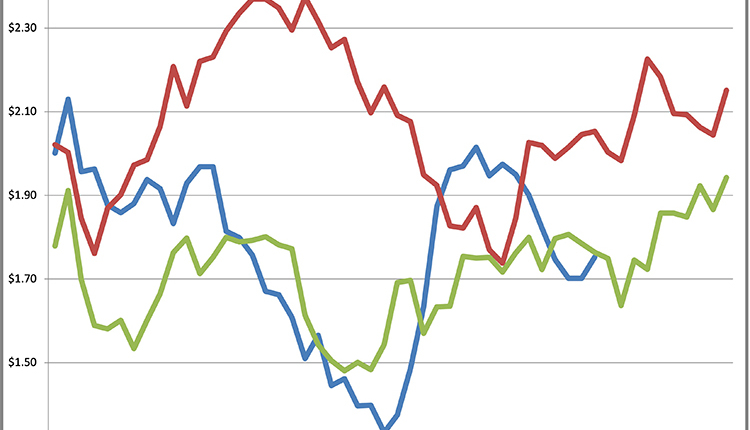The information below has been supplied by dairy marketers and other industry organizations. It has not been edited, verified or endorsed by Hoard’s Dairyman.
Sorghum’s uptake in dairy rations has continually grown, but the crop's limiting factors have laid hurdles for those who desire to partially replace corn silage in the diet while promoting water use savings. The team at Texas A&M University developed a means to control and even avoid some of these former challenges with the new male sterile sorghum variety.
“When we started the research, we didn’t have the technology to process the berries properly,” explains Douglas Duhatschek, extension graduate assistant under Juan Pineiro at the Texas A&M AgriLife Research and Extension Center. “The first big opportunity with male sterile hybrids is they don’t develop the grains, so you don’t have to worry about processing.”
No grain, no problem
The male sterile sorghum has opened a few treasure chests since its humble beginnings. The plant develops the hat, but because there is no pollination, it doesn’t further advance into the later stages of maturity that include grain development.
“In non-sterile sorghum, advancing maturity stages increases lignification, causing the digestibility of the fiber to decrease - which is why producers harvest at a younger maturity,” explains Duhatschek. The male sterile sorghum variety stays green and seems to retain its bottom leaves longer than the traditional sorghum varieties. It also preserves its high fiber digestibility and accumulates sugars as a trade-off with starch synthesis in the absence of grain development.
High-sugar silage is nutritionally desirable for dairy cattle as a great source of energy. “What we often see is that the sugar content [of the male sterile variety] is high at four to six weeks after boot stage. The more you wait, you’re accumulating sugar - up to eight weeks,” shares Duhatschek. The high sugar content also supports fermentation during the silage-making process, helping prevent undesirable fermentation as the male-sterile variety often has low dry matter content.
Harvest Timing
The long-standing recommendation for traditional forage sorghum harvest is at the soft dough stage as the crop offers higher starch digestibility in this time frame - especially when berry processing was not ideal.
“The window that we had for harvesting that sorghum was very narrow - around five to ten days for soft dough and ten to fifteen for hard dough,” shares Duhatschek. “When we have a male sterile sorghum, we don’t have to worry about the berries, so our window is much wider - allowing large and small producers have more flexibility with their logistics at harvest.”
Research
The Texas A&M team took to feeding trials to capture the capabilities of the male sterile sorghum in lactating dairy diets. Duhatschek explains, “We fed incremental replacement rates of corn silage with male sterile sorghum. We used a 0% replacement, 25% replacement of the corn silage with male sterile sorghum, and 50%. Twenty-five percent was the group that yielded the best results.”
The experiment utilized a high-starch diet fed to cows with an average 120 days in milk. The team brought in dry ground corn to make up for the starch lost in the replacement of corn silage with male sterile sorghum silage. “When you compare the starch between the corn silage and dry ground corn, the rate of digestibility in the rumen is different. The corn silage digests at a much higher rate as it's much more fermentable in the rumen than dry ground corn,” explains Duhatschek.
The digestion of the starch moves from the rumen into the intestines of the animals. This gives the cows more chances to absorb glucose, which can go to the mammary gland to increase lactose production. As such, the trial resulted in greater milk production for the sorghum diets.
Considerations
While the male sterile sorghum has much to offer, Duhatschek and his team remind farms that proper crop and ration management is key to success. The first of these is starch sources. “Perhaps doing a steam-flaked corn to replace part of the dry ground corn, or using a high-moisture sorghum might be an option as well,” shares Duhatschek. These faster-digesting alternatives may help replace the gap left when corn silage is replaced or removed.
Because the male sterile doesn’t develop grain, it struggles to dry down. “You usually end up harvesting a material that is high in moisture. Anywhere between 70-80% moisture, depending on how you manage it.” This could lead to the environmental risk of leachate production during packing and ensiling.
Higher sugars also put the male sterile variety at a higher risk of bunk instability that can change throughout the year, especially in summer.
At the end of the feeding trial, the male sterile sorghum was shown to increase income over feed costs within the high starch diet with late lactation cattle - leading Duhatschek and his team to tout its premise within the optimal management scheme. The opportunities to even partially replace a water-hungry forage crop with a dry ground resilient forage crop, while optimizing production, could be gold. Especially for those in the western US.
Learn more about sorghum and beyond from Texas Agri-Life Extension and Research through Texas Dairy Matters. Users can find published research findings, resources, and contacts at https://texasdairymatters.tamu.edu/.
Founded in 1976, Rock River Laboratory is a family-owned laboratory network that provides production assistance to the agricultural industry through the use of advanced diagnostic systems, progressive techniques, and research-supported analyses. Employing a team of top specialists in their respective fields, Rock River Laboratory provides accurate, cost-effective, and timely analytical results to customers worldwide, while featuring unsurpassed customer service.






